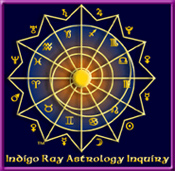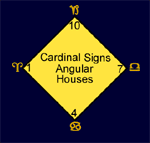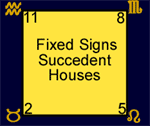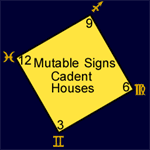
|
|
- MC
- See
Medium Coeli
|
- Malefic
- A
term used in Classical and Medieval/Renaissance Astrology that
refers to planets or aspects thought to have negative influence
on the native. It usually refers to the planet Saturn
and Mars,
the Major Malefics (or Greater) . In modern Astrology minor Malefics
(or Lesser) are also Uranus,
Neptune
and Pluto.
|
- Masculine
Signs
- Air
and Fire
Signs. Those signs, regardless of gender that suggest aggressiveness,
directness In antiquated Astrology texts they are referred to
as the Positive Signs or Active Signs.
|
- Medium
Coeli, Med. Coeli, MC
- The
Midheaven.
Taken to be the point directly overhead. In the chart in an unequal
chart it is the cusp of the tenth house. This describes your career
and public ambitions and your relations with superiors.
|
- Meridian
- The
invisible lines surrounding the Earth that run North to South
and are measured in degrees. The Prime Meridian is 0 degrees at
Greenwich England.
|
- Midheaven
- The
point when the Meridan of the birthplace intersects the ecliptic.
Defined as the cusp of the 10th house in most house systems, See
also Medium Coeli, Mid. Coeli, MC
|
- Midnight
- Can
be defined at 00:00 hours, the beginning of the day—or at
24:00 hours, the end. Most astrologers use 24:00 hours to mean
Midnight. Midnight ephemeris is always a zero hour ephemeris.
|
- Midpoints
- Sensitive
points halfway between two factors in a horoscope.
|
- Moon
Nodes
- The
astronomical calculation of when the Moon's orbit intersects with
the Sun's orbit. The two intersecting points located opposite
each other in the Zodiac are differentiated by ascending
and descending or more commonly, North and South Nodes.
If the Sun and the Moon are positioned at one of these nodes,
there is a solar eclipse. In Karmic Astrology the Moon Nodes have
a leading role.
|
- Mutable
Signs (a.k.a. common)
- The
signs Gemini,
Virgo,
Sagittarius
and Pisces.
Signs associated with adaptability and flexibility.They also correspond
to the Cadent
Houses in the Wheel identified as part of the
Quadruplicities.
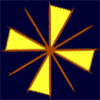
|
- Mutual
Reception (see diagram)
- Two
planets are said to be in mutual reception when they are in each
other's signs of rulership. The example in the diagram is
Mars in Taurus and Venus in Aries.Each planet has influence over
the others' sign. Referring to one directs you to the other
and then refers you back to the originating planet. Much like
an endless loop. Because they are in each other
signs they mutually support each other.
-
|

|
|
- Nadir
- See
Imum
Coeli
|
- Natal
Chart see also Horoscope
- A
chart of the solar system based on the Birth Data of an individual.
|
|
Natural
Houses or Flat Chart
The display of the horoscope
wheel houses beginning with Aries as the first house cusp
then Taurus, Gemini, etc. in order, continuing counter clockwise
until the 12th house, Pisces,
meets the first house, Aries.
|
- Node
- The
point of interception between a planet's orbit and the ecliptic.
See also Moon
Nodes
|
- North
Node
- see
Moon
Nodes
|
- Novile
- A
minor aspect between two planets or points that measures 40°.
Some interpretations include brooding, realization and/or redemption.
The glyph for the Novile varies according to the software
program. Some just use the capital "N" and others have
more elaborate symbols as
 .
(See Legend) .
(See Legend)
|

|
|
- Occultations
- Usually
referred to when the Moon eclipses another object in the sky particularly
a smaller object from our view on Earth. The word is derived from
the Latin root "occult" which has nothing to do with
the supernatural and simply means "to conceal or hide".
An animated example can be viewed here.
Some Astrologers interpret according to what the Moon is eclipsing
and for how long.
-
|
- Opposition
- An
aspect representing an angular difference of 180 degrees or a
situation where two planets are directly across a chart from each
other. Generally this can cause difficulty and discord.
|
- Orb
- The
difference between an exact aspect
and the actual aspect. It also describes the maximum difference
where an aspect still takes place. This is the amount allowed
on either side of an aspect to be considered valid. For example:
a square is an aspect of 90°.
If an aspect falls within 85° to 95° of each other it
would be considered "in square." Individual astrologers
assign the orb for the chart based on their own research and data.
This varies from one astrologer to the other.
|

|
|
- Parallel
- An
aspect in declination where two planets are in the same degree
(with an orb of 1 degree), both North or both South of the celestial
equator. Read by most astrologers as similar to a conjunction.
|
- Part
of Fortune
- Arabian
part most commonly used by astrologers. Found by subtracting Sun's
position from the sum of the Ascendant and Moon positions in degrees.
Suggest fortunate circumstances.
|
- Peregrine
- Planet
positioned in a sign where it posesses no essential dignity. It
is neither dignified nor debilitated. It is a planet that
seems to be independant of others. In interpretation in Horary
Astrology, the astrologer determines if it could be a debility
by where it is placed in degrees and relationship to angles of
specific houses as appropos to the question. Planets that
enjoy mutual reception can not be considered
peregrine. The simple determination on whether or not a planet
is peregrine is if it is unaspected.
|
- Personal
Planets (inner planets)
- Mercury,
Venus and Mars are considered the Personal or Inner Planets for
purposes of interpretation.
-
-
|
- Personal
Points
- The
assigned points in a horoscope that are important to the interpretation
as a whole but are not necessarily planets or the luminaries.
An example of a personal point would be the Ascendant
and the Midheaven (M.C)
and often are the points identified by the angles of the horoscope.
|
- Placidus
- Spanish
Monk. Placidus de Tito, 17th century. Creator of the Placidus
House System.
One of the most commonly used house systems today.
|
- Planet
- From
the Greek "Planetes" or the wanderer. Describes any
body that appears, from Earth, to move.
|
- Planets
- The
planets in Astrology are considered the TEN planets: Sun,
Moon,
Mercury,
Venus,
Mars,
Jupiter,
Saturn, Uranus,
Neptune
and Pluto.
However, this is an astronomical error because the Sun and Moon
are not considered planets by the strictest definition. This definition
of the planets dates back to the times when the Earth was considered
the center of Universe. The Sun and the Moon are considered the
Luminaries
or Lights in astrology although treated as planets. It is important
to note that western astrology has extended astronomical discoveries
to the science. Chiron
is now treated as a Planet although considered a planetoid or
rogue asteroid between Saturn and Uranus. Asteroids
alone are now considered part of the equation in erecting a chart
for individual. The science of Astrology progresses along side
the science of Astronomy.
|
- Precessions
- The
slow advancement of the fixed-star
heavens through the movement of the Earth's axis. Therefore, the
constellations,
which gave the signs of the zodiac their names, move another 1°
every 72 years. The result is the advancement of the firmament
for the length of an astrological sign (30°) every 2160 years.
This movement is designated in Astrology as new era or age (e.g.
Aquaria Age). As a result western Astrology sees the constellations
as only donors of their name to the science, precessions are not
as emphasized in the western practice of Astrology.
|
- Predictive
Astrology see Current
Patterns.
|
- Prime
Meridian
- The
line of longitude that passes through Greenwich, England, and
that is the zero line for expressing longitude on the Earth's
surface.
|
- Progressions
- Term
used for advancing planets and house cusps from birth to a second
point in time. Usually one day for each year. The systems of studying
current patterns that move the chart symbolically forward or backward
according to one unit of time equated with another. The most common
form, secondary progression, is the usual one day for each year.
Thus if a person is now 30 years old, the positions 30 days after
birth are considered symbolic of that of the 30th year. Other
systems of progressions equate a lunar month with a year, ad with
a lunar month and so on.
|
- Ptolemaic
Aspects
- The
aspects that are considered MAJOR. Opposition, Trine, Square and Sextile as well Conjunction.
|

|
|
- Quadruplicities
- The
qualities of the astrological zodiac signs defined as either,
Cardinal,
Mutable or
Fixed. Also describing the
Natural Houses qualities. Also known as Modes.
-
-
|

|
|
- Regiomontanus
- German
Astrologer, (Johannes Müller) 15th century, who devised the
Regiomontanus House
System. The House system most often used in Classical
Horary Astrology.
|
- Relative
House or Relationship
Houses
- Houses
3, 7 and 11. Associated with the Air
Signs.

|
- Retrograde
 Apparent
backward motion of a planet as appearing from the Earth. Thought
to cause difficulty in a person's chart. Click here
for an animation of what astronomically is happening! Apparent
backward motion of a planet as appearing from the Earth. Thought
to cause difficulty in a person's chart. Click here
for an animation of what astronomically is happening!
|
- Return
Chart
- A
chart calculated for the moment a planet returns to the same position
it held in the Natal Chart. Used to interpret current patterns
for the time period signified by the return, e.g. Solar Return
for one year. Lunar Return for one month.
-
-
|
- Rising
Sign
- Another
word for Ascendant.
For more information to this page.
|
- Ruler
- Each
astrological sign and house is governed by at least one planet
(or body). The planet is said to rule that sign or house.
In the opposing sign and/or house, the planet is in its detriment
or
fall.
Example: Aries is ruled by Mars and is opposite of Libra. Mars
in Libra would be considered in detriment. A planet that is positively
placed is considered exalted
if in the sign that is complementary. Example: Mars in Aries would
be considered dignified
or dignity. It would be exalted in Capricorn and Fall in
Cancer the opposite of the exaltation. (see
Table of Planetary Rulership)
|
